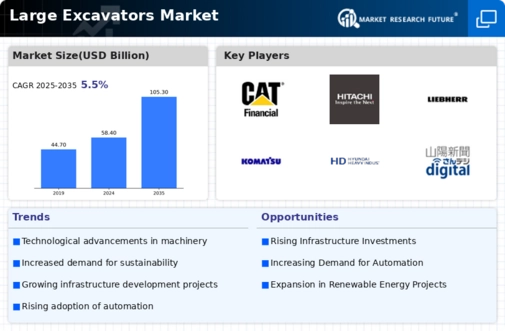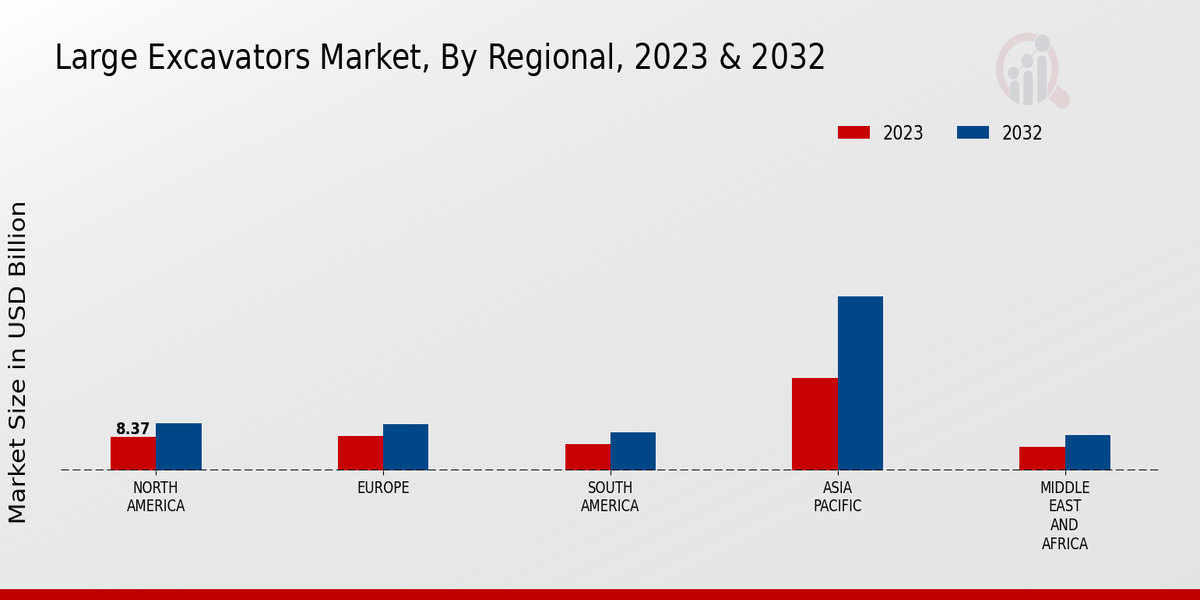Mining Sector Expansion
The expansion of the mining sector is a significant driver of the Global Large Excavators Market Industry. As global demand for minerals and resources continues to rise, mining companies are investing heavily in excavation equipment to enhance their operational capabilities. Large excavators are essential for various mining activities, including site preparation, material handling, and overburden removal. This increasing investment in mining infrastructure is likely to contribute to the market's growth, with projections indicating a market value of 58.4 USD Billion in 2024. The mining sector's robust demand for large excavators is expected to sustain the industry's momentum in the coming years.
Market Growth Projections
The Global Large Excavators Market Industry is projected to experience substantial growth over the next decade. With an estimated market value of 58.4 USD Billion in 2024, the industry is expected to reach 105.3 USD Billion by 2035. This growth trajectory reflects a compound annual growth rate of 5.51% from 2025 to 2035. Factors such as infrastructure development, urbanization, and technological advancements are anticipated to drive this expansion. The increasing demand for large excavators across various sectors, including construction and mining, underscores the industry's potential for growth in the coming years.
Urbanization and Population Growth
Rapid urbanization and population growth are pivotal factors driving the Global Large Excavators Market Industry. As urban areas expand, the demand for residential and commercial construction increases, necessitating the use of large excavators for efficient earthmoving and site preparation. According to projections, urban populations are expected to rise significantly, particularly in developing regions. This urban expansion creates a pressing need for infrastructure development, which in turn fuels the demand for large excavators. The anticipated growth in urbanization is likely to support the market's growth trajectory, contributing to a compound annual growth rate of 5.51% from 2025 to 2035.
Infrastructure Development Initiatives
The Global Large Excavators Market Industry is experiencing a surge due to extensive infrastructure development initiatives worldwide. Governments are increasingly investing in transportation networks, including roads, bridges, and railways, to enhance connectivity and stimulate economic growth. For instance, the United States has allocated substantial funding for infrastructure projects, which directly boosts demand for large excavators. This trend is expected to contribute to the market's valuation of 58.4 USD Billion in 2024, with projections indicating a rise to 105.3 USD Billion by 2035. Such investments are likely to drive the need for advanced excavation equipment, thereby propelling the Global Large Excavators Market Industry forward.
Regulatory Support for Sustainable Practices
Regulatory support for sustainable practices is emerging as a key driver in the Global Large Excavators Market Industry. Governments worldwide are implementing stringent regulations aimed at reducing environmental impact and promoting sustainable construction practices. This regulatory landscape encourages manufacturers to develop eco-friendly excavators that comply with environmental standards. As a result, the demand for large excavators equipped with advanced emission control technologies is likely to increase. Such regulatory frameworks not only foster innovation but also create a competitive advantage for companies that prioritize sustainability, thereby influencing the overall growth of the Global Large Excavators Market Industry.
Technological Advancements in Excavation Equipment
Technological advancements play a crucial role in shaping the Global Large Excavators Market Industry. Innovations such as automation, telematics, and improved fuel efficiency are enhancing the performance and productivity of large excavators. For example, manufacturers are increasingly integrating smart technologies that allow operators to monitor equipment performance in real-time, leading to reduced downtime and increased operational efficiency. These advancements not only improve the functionality of excavators but also align with the industry's sustainability goals by reducing emissions and fuel consumption. As a result, the demand for technologically advanced large excavators is expected to rise, further propelling the market's growth.























